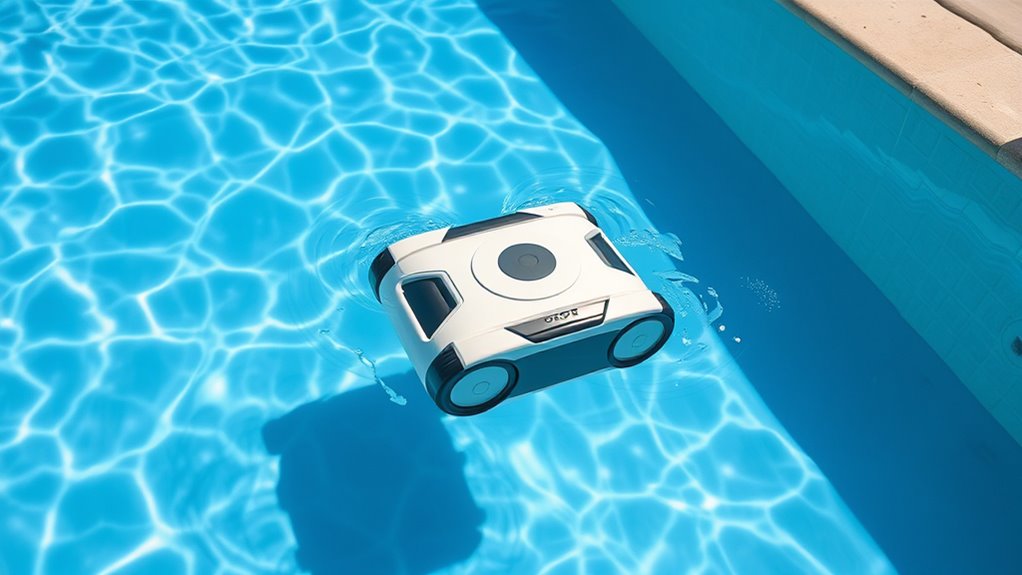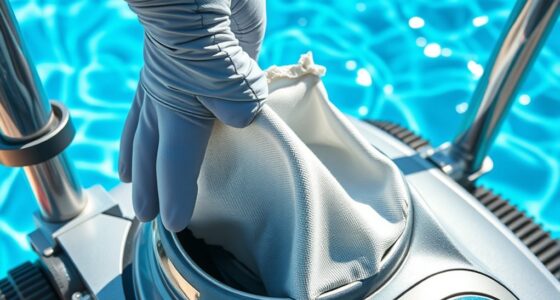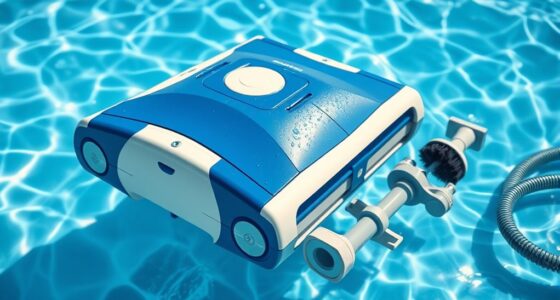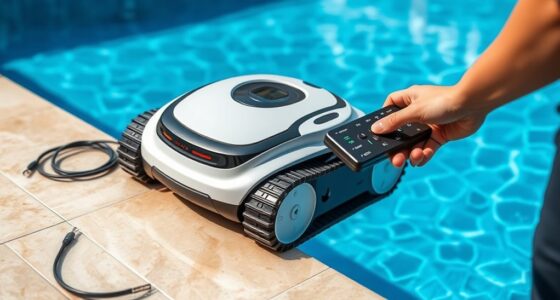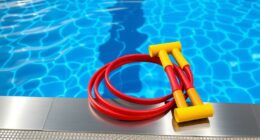To get the best use from your suction pool cleaner, avoid common mistakes like skipping proper priming, neglecting regular maintenance, and using the wrong hose length. Make sure all connections are secure, the water level is correct, and debris is cleared beforehand. Don’t run it too long or too short, and operate on suitable surfaces. Staying aware of these tips helps prevent issues; keep going to learn more ways to improve your cleaner’s performance.
Key Takeaways
- Ensure the cleaner is properly primed and all connections are tight to prevent leaks and loss of suction.
- Use the correct hose length and secure fittings to avoid tangling, leaks, and reduced cleaning efficiency.
- Maintain the appropriate water level and good circulation for optimal cleaner movement and debris pickup.
- Avoid running the cleaner for excessively long periods, typically 2-4 hours, to prevent motor wear.
- Regularly remove debris and check for obstructions to prevent clogging, damage, and missed cleaning areas.
Failing to Properly Prime the Cleaner and Skimmer Basket

Before using your suction pool cleaner, it’s crucial to properly prime the device and verify the skimmer basket is clear. If the water temperature is too low or high, it can affect the cleaner’s performance. Before starting, check that the pool chemical levels are balanced, as imbalanced chemicals can cause debris buildup that hampers suction. Make sure the skimmer basket isn’t clogged, which can reduce water flow and weaken the cleaner’s ability to pick up debris. Proper priming involves submerging the hose to remove air and confirm water flows smoothly into the cleaner. Failing to do this can lead to suction loss or inefficient cleaning. Additionally, understanding the contrast ratio of your pool equipment can help you better assess the effectiveness of your cleaning process. Taking these steps guarantees maximum water flow, better debris removal, and prevents unnecessary strain on your pool equipment.
Ignoring Regular Inspection and Maintenance of the Cleaner
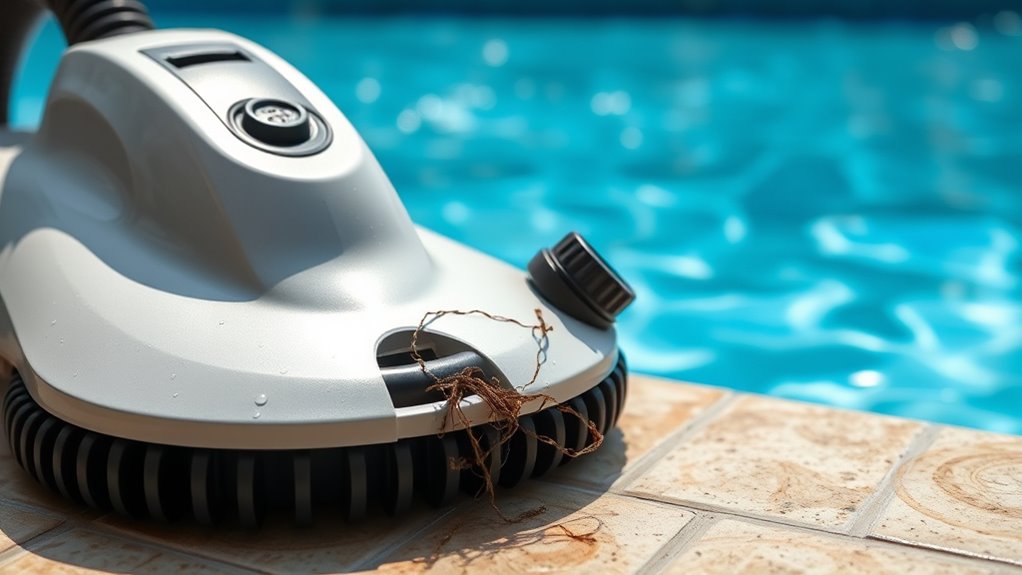
Neglecting regular inspection and maintenance of your suction pool cleaner can lead to performance issues and costly repairs. You should routinely check for debris, wear, and tears, ensuring the brushes and wheels move smoothly. Familiarity with the user manual helps identify specific maintenance needs. Also, maintaining proper pool chemical balance prevents buildup that can clog the cleaner. Regularly inspect hoses and connections for leaks or blockages. Additionally, understanding the self-watering plant pots can help prevent similar issues related to moisture and debris buildup in your pool system. Being aware of essential oils for maintenance may also inspire you to incorporate natural cleaning solutions or preventative measures. Incorporating routine filter cleaning can further enhance the efficiency of your pool cleaning system and extend its lifespan. Moreover, adopting a preventative maintenance schedule can help catch potential problems early before they develop into expensive repairs.
Using the Incorrect Hose Length or Not Securing Connections Properly
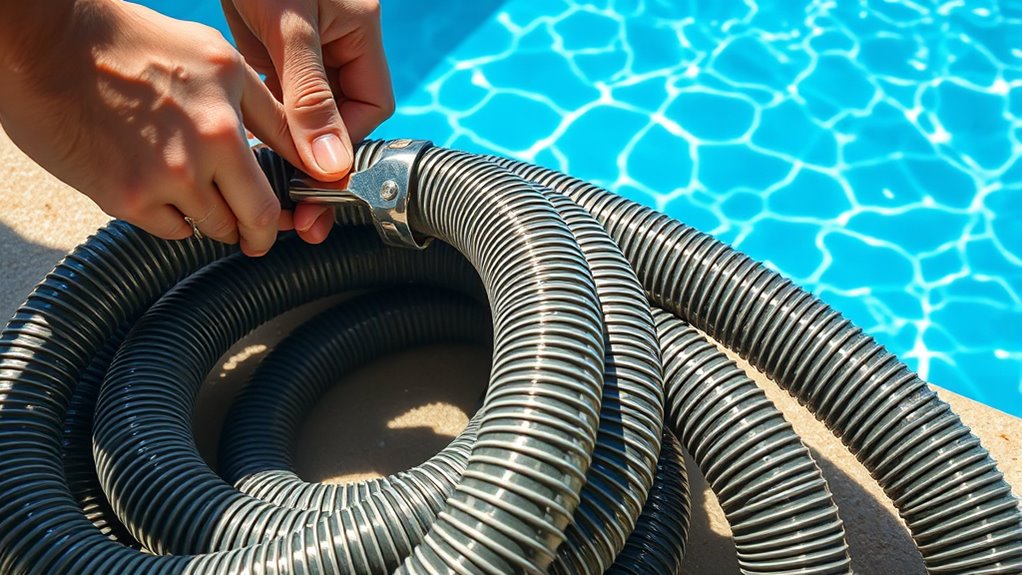
Using the wrong hose length can reduce cleaning efficiency and cause tangling or gaps. Make sure your hose fits your pool size and setup properly. Also, double-check that all connections are tight and secure to prevent leaks and loss of suction. For wireless convenience, some models support Bluetooth connectivity, but ensure your device is compatible to avoid frustration. Properly maintaining your pool equipment can also extend its lifespan and improve overall performance. Incorporating literary humor can make troubleshooting tips more engaging and memorable.
Proper Hose Length Choice
Choosing the correct hose length is essential for your suction pool cleaner to operate efficiently. If the hose is too long, it can cause tangling and reduce suction power; if it’s too short, the cleaner won’t reach all areas. Measure your pool and select a hose length that allows the cleaner to move freely without excess slack. An appropriate hose length ensures smooth movement and prevents strain on the proper connection points. Always verify that the hose fits snugly and securely into the skimmer or dedicated cleaner port. Proper connection is key to maintaining consistent suction and avoiding leaks. Hose compatibility is crucial for optimal operation, so ensure the hose you choose is compatible with your specific pool cleaner model. Additionally, proper maintenance of the hose and connections can prevent common issues such as leaks or blockages. By choosing the right hose length and ensuring proper connection, you’ll maximize your cleaner’s performance and minimize the risk of operational issues.
Secure Connection Techniques
A secure connection is essential for your suction pool cleaner to work effectively, but many users make the mistake of not properly securing hoses or using the wrong length. An improper connection can cause leaks, reduced suction, or the cleaner losing track of the pool floor. Always verify hoses are tightly connected and use a hose length appropriate for your pool size to maintain ideal cleaning. Before starting, check your pool’s chemical balance to prevent corrosion or damage to equipment. Additionally, follow safety precautions by inspecting connections regularly and avoiding kinks or loose fittings. Properly secured hoses not only improve cleaning efficiency but also reduce the risk of accidents or equipment failure, ensuring a safer, more effective pool maintenance routine.
Overlooking Pool Water Level and Circulation Settings

Ignoring the pool’s water level and circulation settings can markedly hinder your suction pool cleaner’s performance. If the water level is too low, the cleaner may lose suction or get stuck, reducing cleaning efficiency. Conversely, an excessively high water level can cause poor circulation, leading to debris buildup and uneven cleaning. Proper circulation guarantees the cleaner moves smoothly and covers the entire pool surface. Additionally, neglecting water chemistry can impact the cleaner’s operation, as imbalanced water affects pump efficiency and energy consumption. Maintaining ideal circulation not only improves cleaning but also enhances energy efficiency, saving you money. Always check and adjust your pool’s water level and circulation settings regularly to ensure your suction cleaner performs at its best.
Not Clearing Obstructions From the Cleaner’S Path

Failing to check for debris and obstructions can cause your cleaner to stall or work inefficiently. Make it a habit to inspect the path regularly and remove any blockages promptly. Keeping the cleaner’s way clear guarantees it operates smoothly and saves you time and frustration. Additionally, ensuring the proper functioning of cookies and site features can enhance your overall experience during maintenance. Regularly monitoring the juice yield from citrus fruits can help you understand how much juice to expect and prevent overloading your cleaner with large debris. Moreover, understanding the data privacy challenges and ethical considerations behind algorithms can inspire you to upgrade your own car for better performance and driving enjoyment.
Regularly Inspect for Debris
Regularly inspecting your suction pool cleaner for debris guarantees it operates effectively and prevents clogs. Debris buildup can reduce cleaning performance and disrupt your pool’s pool chemistry, leading to algae growth or cloudy water. By checking the cleaner’s intake and brushes often, you ensure it can move smoothly across the pool floor. Keeping the filter and hoses clear also boosts energy efficiency, saving you money on power consumption. A clean cleaner maintains ideal suction, reducing strain on your pump and prolonging its lifespan. Regular inspections help you catch small issues before they become costly repairs. Additionally, inspecting the HEPA filtration system can prevent smaller particles from bypassing filtration and ensure the air purifier functions at optimal levels. Performing routine maintenance on your cleaner is essential for longevity and peak performance. Make it a habit to remove leaves, dirt, or twigs promptly, and regularly check your system components to ensure all parts are functioning correctly. Also, paying attention to detergent residues can prevent buildup that hampers cleaning efficiency. Incorporating regular cleaning schedules can further prevent debris accumulation and keep your pool pristine. By doing so, you ensure your cleaner functions at its best and your pool stays crystal clear.
Remove Obstructions Promptly
Promptly removing obstructions from your pool cleaner’s path keeps it moving smoothly and maintains ideal cleaning performance. When debris or obstacles block the cleaner, it can get stuck or miss areas, leading to uneven cleaning. Regularly check for obstructions caused by leaves, toys, or even pool lighting fixtures. Additionally, maintaining proper pool chemical balance prevents buildup that could interfere with the cleaner’s suction. Keep an eye on pool lighting, as loose fixtures or cords can snag the cleaner. Clearing obstructions quickly ensures the cleaner operates efficiently and reduces wear and tear. This simple step helps your cleaner do its job effectively, saving you time and effort while keeping your pool pristine.
Running the Cleaner for Too Long or Too Short Periods
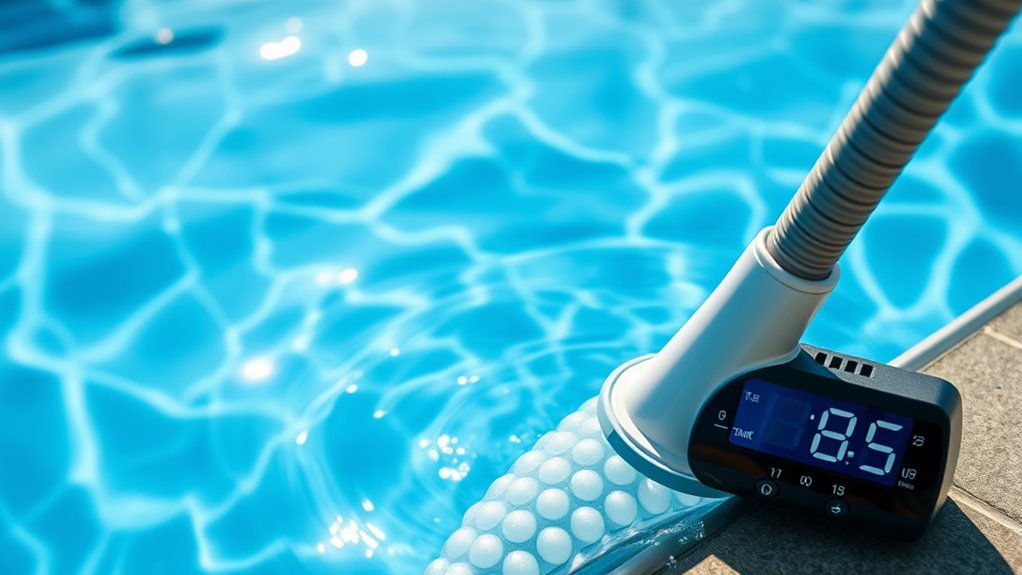
Running your suction pool cleaner for the right amount of time is crucial to guarantee effective cleaning without causing unnecessary wear. The ideal duration depends on your pool’s type of pool and the cleaner brand you use. Typically, running the cleaner for about 2 to 4 hours is sufficient for most pools. If you run it too long, you risk overworking the motor and wearing out parts prematurely. Conversely, running it too short may leave debris behind, requiring additional cleaning sessions. Monitor your cleaner’s performance and adjust the run time accordingly. Always follow the manufacturer’s recommendations for your specific cleaner brand and pool type. Proper timing ensures your cleaner works efficiently and lasts longer, saving you time and money in the long run. Additionally, understanding the best cleaning practices can help you optimize your pool maintenance routine.
Neglecting to Remove Debris From the Pool Before Cleaning
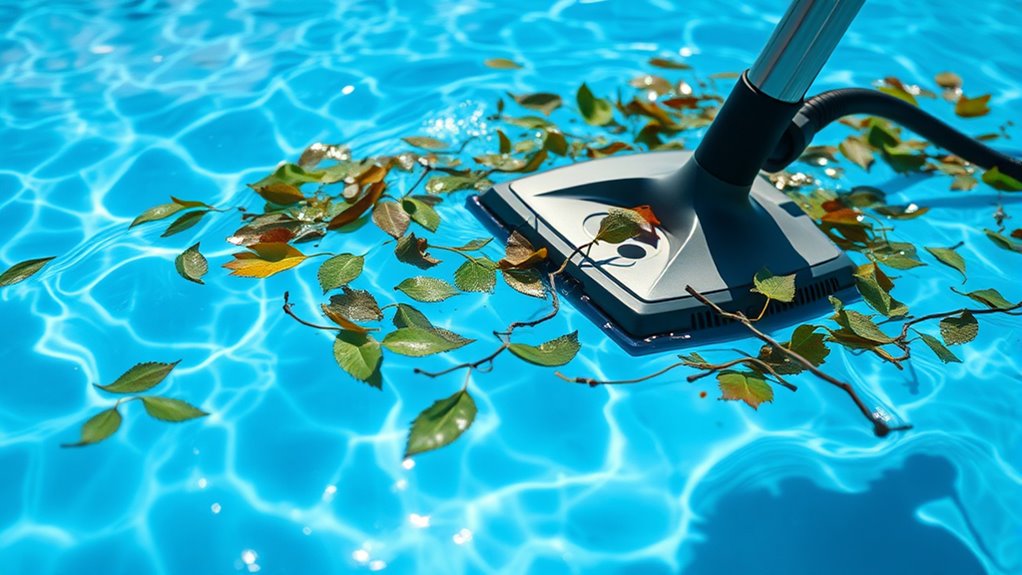
Failing to remove large debris from the pool before starting your suction cleaner can hinder its effectiveness. Heavy leaves or toys can clog the vacuum, reducing cleaning performance and potentially damaging the equipment. Additionally, neglecting debris affects pool safety by creating uneven surfaces that may cause slips. It also disrupts the chemical balance, as organic material can decompose and alter pH levels. To visualize this, consider the table below:
| Debris Type | Effect on Pool Cleaning |
|---|---|
| Large leaves | Clogs suction, reduces cleaning efficiency |
| Twigs and toys | Obstructs movement, damages parts |
| Organic matter | Disrupts chemical balance, staining pool |
Always clear out debris beforehand to ensure best possible cleaning, maintain pool safety, and keep the water chemistry balanced. Remember that keeping the pool free of debris also helps prevent clogging issues that can require costly repairs or maintenance.
Operating the Cleaner on Unfavorable Pool Conditions or Surfaces
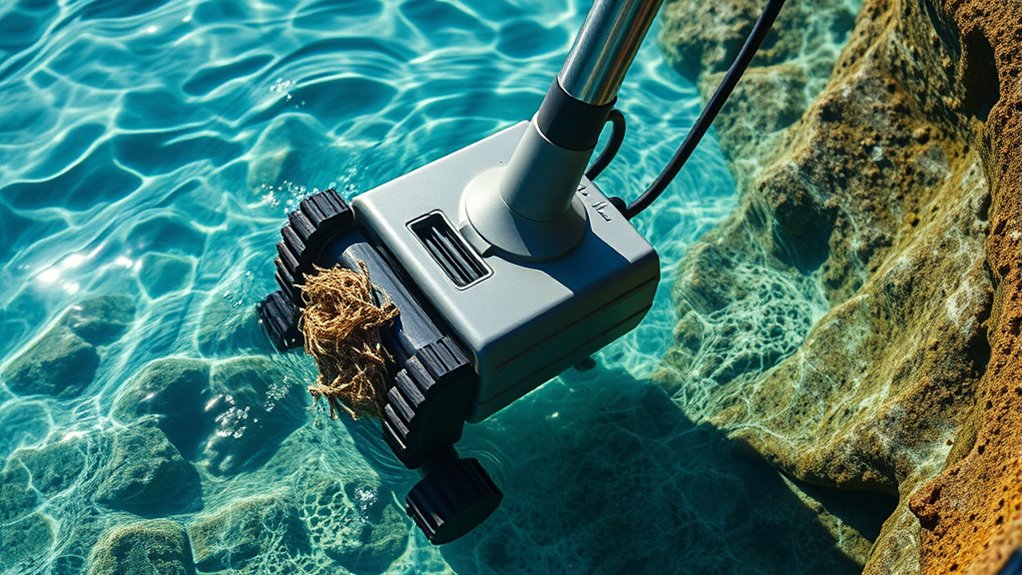
Using a suction pool cleaner on surfaces or in conditions that aren’t ideal can considerably reduce its effectiveness and even cause damage. Unsuitable surfaces, such as rough or uneven pool bottoms, can clog or damage the cleaner’s components. Poor pool chemical balance, like low pH or high algae levels, can also hinder cleaning performance and promote surface buildup. Additionally, if your pool liner isn’t in good shape, the cleaner might snag or cause tears, compromising its integrity. Always verify the pool’s surface is smooth and free of large debris. Maintain proper chemical balance to prevent surface damage and optimize cleaner operation. Avoid running the cleaner on unbalanced or rough surfaces, as this can lead to inefficiency and potential costly repairs.
Neglecting to Adjust or Replace Worn Parts and Filters
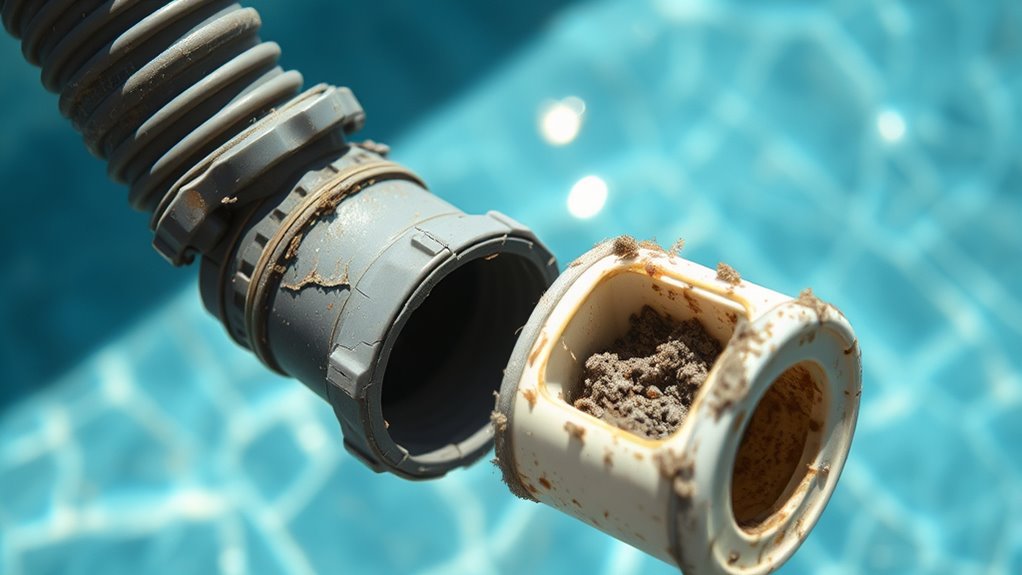
Neglecting to adjust or replace worn parts and filters can substantially reduce your suction pool cleaner’s efficiency. Worn parts, like brushes or rubber seals, lose their effectiveness over time and can cause leaks or uneven cleaning. Regularly inspecting these components allows you to catch issues early. Additionally, neglecting filter replacements leads to clogged filters, restricting water flow and decreasing suction power. Dirty filters force the cleaner to work harder, increasing wear and tear. To keep your cleaner performing at its best, check parts frequently and replace any worn or damaged components promptly. Don’t ignore signs of deterioration—timely maintenance ensures maximum suction, better cleaning performance, and extends the lifespan of your pool cleaner. Staying proactive with adjustments and replacements saves you time and money in the long run.
Frequently Asked Questions
How Often Should I Inspect My Suction Pool Cleaner for Wear and Tear?
You should inspect your suction pool cleaner regularly to keep it in top shape. Follow a maintenance schedule, checking for signs of wear and tear at least once a month. Use an inspection checklist to look for damaged hoses, worn brushes, or clogged filters. Regular inspections help you catch issues early, preventing breakdowns and ensuring your cleaner works efficiently, saving you time and money in the long run.
Can Using the Wrong Cleaning Cycle Damage My Pool Cleaner?
Using the wrong cleaning cycle can be a disaster waiting to happen, like inviting chaos into your pool! If you choose an unsuitable cycle, it might overwork your cleaner, cause a debris clog, or even damage delicate parts. Always match the cycle to your pool’s needs and avoid using harsh pool chemicals that can weaken components. Proper cycle selection keeps your cleaner running smoothly and your pool crystal clear.
What Are the Signs That My Skimmer Basket Needs Replacement?
You’ll know your skimmer basket needs replacement when you notice debris buildup that doesn’t clear after cleaning, or if the basket is cracked or damaged. Replacement signs also include frequent filter clogs or reduced water flow, indicating the basket can’t trap debris effectively. Regularly check your skimmer basket and replace it promptly to keep your pool clean and your filtration system running smoothly.
How Do I Troubleshoot Poor Suction Performance?
Think of your pool’s suction as a gentle but powerful flow—when it falters, check your filter maintenance first; debris can clog the system like knots in a rope. Next, inspect the hose connection—loose or kinked hoses obstruct the flow, like a dam holding back water. Tighten fittings, clear obstructions, and ensure everything’s connected snugly. With these steps, your pool cleaner will glide smoothly, restoring that steady, clean sweep.
Is It Necessary to Change Filters More Frequently During Heavy Debris Seasons?
During heavy debris seasons, you should change your filters more frequently to prevent debris accumulation, which can reduce suction performance. This helps extend the filter lifespan and keeps your pool cleaner running efficiently. Regularly inspecting and replacing filters ensures peak suction, so you avoid clogs and maintain proper circulation. Don’t wait until filters are fully clogged; proactive changes during high debris periods keep your suction pool cleaner working smoothly.
Conclusion
By avoiding these common mistakes, you guarantee your pool stays clean and efficient. But even with perfect maintenance, unexpected issues can still arise, reminding you that no system is foolproof. Proper care and attention keep your cleaner running smoothly, yet sometimes, despite your efforts, a problem may surface. It’s this balance between control and unpredictability that makes pool maintenance both a responsibility and a reminder that even the best tools need your vigilant care.
